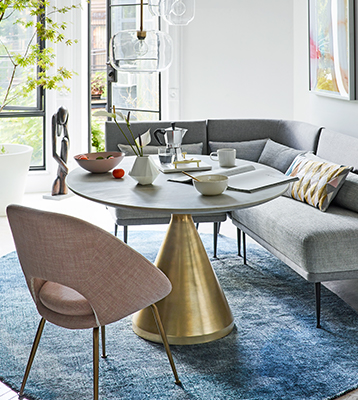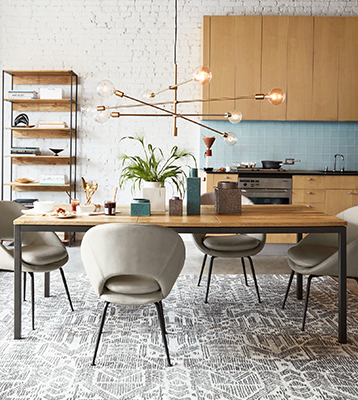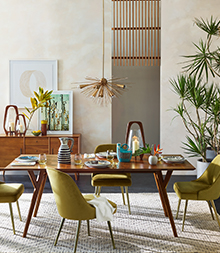Ideas + Advice
Living Room
- Living Room Color Schemes
- How To Create A Living Room-Dining Room Combo
- Choose The Right Fabric
- Guide To Leather Furniture
- Sofa Advisor
- Guide to Sofas
- Guide to Sectional Sofas
- Minimalist Living Room Ideas
- How To Arrange Furniture: Living Room
- How To Decorate With Accent Chairs
- Inspiration: Living Rooms
Office
Bedroom
- Headboard Ideas
- Bedroom Office Ideas
- What Is A Sham
- Stylish Bedroom Storage Ideas
- What Is TENCEL™ Fabric
- What Is A Platform Bed
- What Is A Daybed
- Black and White Bedroom Ideas
- What Is A Coverlet
- Bed Sheet Sizes Buying Guide
- Closet Organization Ideas
- Cozy Bedroom Ideas
- Bedding 101
- Layer Your Bed Like A Stylist
- Tips For Keeping White Bedding Bright
- How To: Create The Perfect Lazy Sunday
- How To: Style Your Dresser
- How To: Fold A Fitted Sheet
- How To: Put On A Duvet Cover
- How To Shop For An Upholstered Bed
- Choose The Right Bed + Headboard
- Inspiration: Bedrooms
Dining Room + Kitchen
Small Spaces
Outdoor + Plants
- How To Choose The Best Material For Outdoor Furniture
- Meet My Plant Fam: Sophia Bush x Plant Kween
- At Home with The Manscapers
- Backyard Party Ideas
- Small Patio Ideas
- Glamping Tips for Beginners
- How to Plan a Road Trip
- How to Camp with Kids
- REI At Home, Outside
- Indoors and Out: Easy Outdoor Ideas for Backyards, Patios and Poolside
- Create an Urban Oasis: Plant Care and Inspiration
- Guide to Outdoor Furniture
- Outdoor Planters 101
- 4 Ways To Upgrade Your Outdoors With Cityscape Planters
- 10 Ways To Get Ready For Summer
- How To: Make A Terrarium
- Create A Great Outdoor Space
- Inspiration: Outdoor Spaces
Lighting
Decorating + Accessories
- Sunroom Decorating Ideas
- Feature Wall Ideas
- Decorating With Mirrors
- How To Style a Modern & Functional Entryway
- Decorate with These Dog-Approved Staples
- Behind the Scenes: Artisan Wall Art Collection
- Create a Calming Space to Inspire Creativity
- La Mesa Collection: Destination Mexico
- Window Treatment Ideas
- Feel Good Color
- Indoors and Out: Decorating with Black and White
- Inspiration: Pillows + Throws
- Choosing Paint Colors
- Choose The Right Curtains
- How To: Hang Curtains
- Choose The Right Rug
- How To Style Your Bookshelves Like A Pro
- Get Organized With Baskets
- All About Wallpaper
- Create A Wood–Paneled Wall
- How To: Create A Gallery Wall
- Decorating With White
- How To Decorate With Color
Entertaining + Holiday
- Bar Cart Ideas
- Tour this Modern and Festive Home
- Fall Table Decor
- Tour this Chic & Sophisticated Holiday Home
- Thanksgiving With Carla Lalli Music
- Christmas Color Palette Ideas
- 32 Christmas Tree Themes For A Festive Holiday
- Holiday Lookbook 2021
- Summer Entertaining with Cloudy Bay
- Practical Housewarming Gifts
- White Christmas Decor Ideas
- Christmas Mantel Ideas
- Apartment Christmas Decorations
- Celebrate the Season: Holiday Lookbook
- Fruit Cake Recipes from Jason Schreiber
- Paper Source Holiday Crafts: Ideas & Instructions
- A Joyful + Modern Holiday Home
- Cooking with Nik Sharma
- How To: Host The Perfect Dinner Party
- Ways To Set Your Holiday Table
- Bar Cart Checklist
- A Guide To Great Gifting
- Last Minute Gift Ideas
- Easy Holiday Decorating
- Decorate Your Tree Like A Pro
- Entertaining With Alison Roman
- 6 Holiday Table Settings Ideas
Bath
Baby + Kids
- Feature Wall Ideas
- Playroom Ideas
- Teenage Bedroom Ideas
- And Just Like That: Get The Look
- Baby Closet Organizing Tips
- Nursery Tour with Maya Erskine
- How to Create a Kids' Home Library in 5 Steps
- Creative Kids' Room Design
- Modern Nursery Ideas
- Sarah Sherman Samuel Loose on Set
- Kids' Bathroom Ideas
- Stuffed Animal Storage Ideas
- Homeschool Room Ideas
- NextWithNita's Dallas Nursery
- Picking the Right Crib Size
- Small Nursery Ideas
- Gender Neutral Nursery Ideas
- Inspiration: Baby + Kids
Tools + Resources
- How To Wash Linen Sheets
- How To Measure For Blinds
- How To Clean A Wool Rug
- How To Clean A Couch
- Comforter vs Duvet
- Measure For Delivery
- Upholstery Fabric Options
- Fabric Swatches
- Upholstery Ordering FAQs
- Assembly Instructions
- Linen vs Cotton
- How To Choose the Best Rug
- Registry Do's + Don'ts
- Behind the Scenes: Tour Our Makers Studio
House Tours
- A Manhattan duplex does minimal luxury right
- A masterclass in warm West Coast vibes
- Girls Room Makeover
- Clean Lines Meet Cozy Vibes
- Historic Home Made Modern
- Tour a Montauk Home with Contemporary Interiors
- Tour a Sophisticated Brooklyn Brownstone
- Small Space: 800 Square Feet in NYC
- Modern Coastal Home
- Peloton's Robin Arzón's New York City Apartment
- A Mid-Century Home in Hudson Valley
- At Home with Heather Taylor
- Sustainable Style: Eco-Friendly Upgrades with Adrian Grenier
- Modern Family Cabin
- Bold Moves: Tips for Sophisticated Style
- Boho Luxe Home
- Kyle Krieger's Work/Live Loft in DTLA
- Horderly House: Professional Organizers at Home
- Hunter House: Barn House Renovation Project
- New Neutrals at The Lorca
- Queer Eye x West Elm Makeover: Philadelphia
- Happy Modern: A Weekend Home on Long Island
- Small Space: Molly Bernard's Brooklyn Apartment
- A+ Style: A-Frame Cabin in California
- Eric Trine's Modern Family Home
- Neutral & Natural Style in Austin, Texas
- At Home With Zosia Mamet
- A Small-Space Studio For 2
- A Master Bedroom Goes Hygge
- A Living Room For All Ages
- Garance Doré's L.A. Home Office
- Small Space In Portland
- Family Friendly In Portland
- Art-Filled Chicago Home
- Eclectic Brooklyn Brownstone
Design Crew
Healthy Home
Weekly Edit
- Weekly Edit: Tour this airy & art-filled home
- Weekly Edit: Year at Home
- Weekly Edit: Meet The Makers
- Weekly Edit: Adrian Grenier's Eco-Friendly Reno
- Weekly Edit: International Women's Day 2021
- Weekly Edit: Meet La Mesa
- Weekly Edit: Nita Mann Nursery Reveal
- Weekly Edit: Kyle Krieger House Tour
- Weekly Edit: Cool & Collected
- Weekly Edit: Your Best Sleep
- Weekly Edit: Bold Moves
- Weekly Edit: Support Small Biz: The Fifteen Percent Pledge
- Weekly Edit: Boho Luxe
- Weekly Edit: Getting Organized
- Weekly Edit: Christmas Ready
- Weekly Edit: Holidays at Home
- Weekly Edit: Gifts with Personality
- Weekly Edit: Joyful Modern
- Weekly Edit: Guest Ready
- Weekly Edit: Design Crew Spotlight: Bronx One-Bedroom
- Weekly Edit: Halloween
- Weekly Edit: New Neutrals at The Lorca
- Weekly Edit: Hunter House
- Weekly Edit: Autumn Entertaining with Nik Sharma
- Weekly Edit: Trevor Project Spotlight
- Weekly Edit: Design School: Foundations 101
- Weekly Edit: Design Crew Spotlight: NYC Studio Apartment
- Weekly Edit: Learn From Home with Steelcase
- Weekly Edit: Cocktail Recipes with Don Julio
- Weekly Edit: Relax
- Weekly Edit: National Ice Cream Day
- Weekly Edit: Small Space Ideas
- Weekly Edit: REI x West Elm: Backyard Ideas
- Weekly Edit: Create Your Dream Nook
- Weekly Edit: Create Your Great Outdoors
- Weekly Edit: Modern Slant for A Frames
- Weekly Edit: Earth Day 2020
- Weekly Edit: Good Vibes
- Weekly Edit: Small Businesses & Local Makers
- Weekly Edit: House Plants
- Weekly Edit: Work From Home
Rules Of Thumb: Dining Room
As you're decorating your dining room, it helps to have some handy rules of thumb. Here's what the pros know that can help you get it right.


DINING TABLES
- Allow 36"-44" from table to wall on each side to have room to pull out chairs. (Allow 54"-62" from table to wall if you want room for a buffet.)
- Round tables are great for square rooms and small spaces, or to foster conversation. They can usually fit more people because there are no corners.
As a rule of thumb:- A 42"-48"-diameter table seats 4
- A 60" table seats 6-8
- Allow about 2' per person at a rectangular table, though you can squeeze in more chairs when needed. Bench seating also works well at rectangular tables, and benches can be tucked under the table when not in use, to create more room.
As a rule of thumb:- A 48"-long table seats 4
- A 60"-72" table seats 6
- An 80"-87" table seats 8
- A 92"-108" table seats 10
- A 120" table seats 12
- Pedestal tables can fit a little more seating because there aren't table legs taking up space.
- Dining tables are typically 30" high, which is also the standard height of most desks, so a dining table can easily double as a desk, and vice versa.
CHAIRS

- Dining chair seats are usually 18"-19" high, but if you want to use armchairs or larger host chairs at your table, measure first to make sure they'll fit comfortably under the table, especially if your dining table has an apron.
- Upholstered dining chairs are generally most comfortable, but look for durable, easy-to-clean fabrics in mid-range or heathered colors that won't show stains. Wood or leather are durable and easy to keep clean.
- Don't be afraid to mix chairs, placing armchairs or upholstered host chairs at the ends of the table.
LIGHTING


- Center a chandelier or pendant on the table, not the room.
- Hang it so the bottom of the light fixture is 30"-36" above the table (32" on average).
- Choose a chandelier about half the width of your dining table. Another rule of thumb is to add the room's length and width in feet. That number in inches suggests a rough size for the diameter of your chandelier.
- Always put chandeliers and pendants on a dimmer if possible.
- For a long, rectangular table, multiple pendants or a linear fixture may work better than a round chandelier.
- Don't limit dining room lighting to chandeliers. Wall sconces will add ambient lighting around the perimeter of the room, and slender table lamps can also work well on a buffet or console table.
- Hang sconces about 60"-64" above the floor (measuring from the center of the back plate), depending on your ceiling height. Allow at least 24"-36" and optimally, 48" between a pair of sconces.

AREA RUGS
- Allow at least 36" from the edge of your table to the edge of the rug, for room to pull out chairs. (Most dining tables will need a rug that's at least 8' wide.)
- Allow at least 12" between the rug and wall if possible.
- Flatweave rugs are a good choice for dining rooms. Tufted and low-pile rugs can also work well, but avoid shags and thick piles that will catch crumbs and be harder to clean. Natural fibers such as sisal can also be harder to clean if there are spills.
DECORATING TIPS
- Keep centerpieces 15" or lower so diners can see each other across the table.
- Balance windows or a large piece of furniture with a large piece of art or mirror on the opposite wall.


